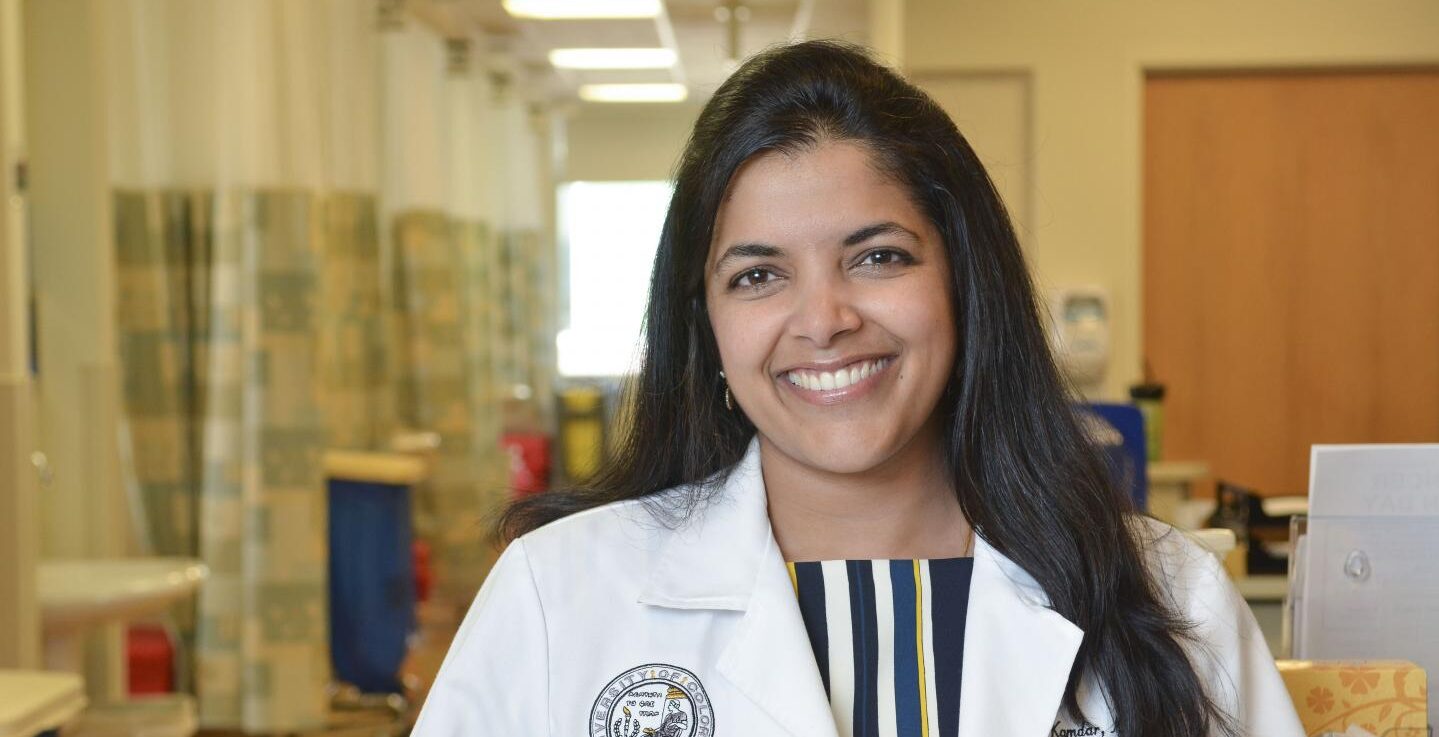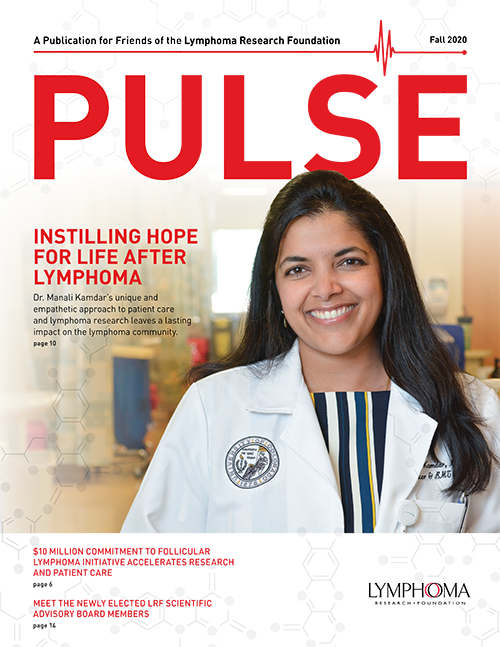
Manali Kamdar, MD, is an oncologist and researcher at the University of Colorado who approaches patient care and lymphoma research in a unique and empathetic manner.
SCIENCE BY SERENDIPITY
Born and raised in Mumbai, India, Dr. Kamdar had dreams of becoming a professional dancer. She danced from the ages of 2 to 18, until an unfortunate fall on stage left her with an injured back and neck and a large decision to make about her future. While healing from her injury, Dr. Kamdar was inspired by her physician’s dedication to helping her get back on the dance floor. “I have always been surrounded by medicine in one way or another,” says Dr. Kamdar. “My mom and grandma have always been interested in integrative medicine. I was an asthmatic child, and I have always felt very well taken care of.” It was then that she decided it was time to reconsider her future and pursue a career in medicine.
“It was my parents who first said to me, ‘You have consistently excelled in the sciences, why don’t you look into that?’ and so I decided to take my medical exams,” says Dr. Kamdar. “Like the saying goes, life is what happens when you’re busy making other plans. I never intended on choosing medicine, it chose me, and I became very passionate about it.” She completed medical school in India and later moved to the United States to complete her residency at East Carolina University. During her training in internal medicine, she took an interest in hematology/ oncology and then applied for a fellowship to delve deeper into the field of clinical cancer care.
“I never intended on choosing medicine, it chose me, and I became very passionate about it.”
As she began her fellowship, she initially split her training between malignant hematology and lung cancer, but it was one of her mentors who nudged her to pursue a career in hematological malignancies. “My mentor suggested I do a rotation at Weill Cornell Medicine with John P. Leonard, MD, and it was during that time I received my first real exposure to the intricacies of lymphomas,” says Dr. Kamdar. With her focus set on a career in lymphoma, she applied for fellowships across the country in the hopes of learning more about lymphomas and transplantation and was accepted into the program at Stanford. Following her fellowship, she wanted to return to India to begin a lymphoma practice in Mumbai, but again her plans changed when she was offered a position as the director of the lymphoma program at the University of Colorado.
“I was very nervous to take on such a huge responsibility as a freshly graduated fellow. However, the idea of building something from scratch in a region devoid of lymphoma expertise was extremely exciting. My dad jokingly said, ‘Look at it as a start-up opportunity; it will either work well or you will fall flat on your face and return home — either way, it would be a win-win for us!,’” says Dr. Kamdar. “I took on the challenge, excited to be able to create the lymphoma program of my dreams — and I started my clinics in January of 2015 and have never looked back.” She credits the leadership at the University of Colorado and several advisors along the way who encouraged and supported her vision. “I have been blessed to have met fantastic senior clinical researchers like Ginna Laport, MD, and Sonali Smith, MD, who stood by me through my professional journey. I hope to do the same for future lymphoma investigators.”
“I took on the challenge, excited to be able to create the lymphoma program of my dreams — and I started my clinics in January of 2015 and have never looked back.”
PRIORITIZING PATIENTS
Dr. Kamdar strives for her lymphoma program to deliver the most comprehensive and advanced care to patients. Her goal is to be able to provide them with the care they need so they may live happy lives beyond lymphoma. To help ensure a brighter future for her patients, Dr. Kamdar has put an emphasis on the psychosocial effect that a diagnosis of lymphoma can have on a patient’s life posttreatment.
“I want my patients to see that there can be so much more to life than just being a ‘cancer survivor,’” says Dr. Kamdar. “I never want my patients waking up every morning worried that their disease will relapse — the goal is to have their lymphoma journey be a part of them, but never the whole part.” By collaborating with a team of psychologists at her institution, she has ensured that her patients have access to a robust support system to help them transition to life after lymphoma. “Being able to be a part of patients’ journeys and make an impact on their lives has undoubtedly been the highlight of my career.”
As an oncologist and a clinical researcher, Dr. Kamdar sees every interaction with patients as an opportunity to learn more about lymphoma and the best ways to treat it. “My clinic days are critical to being able to see my research being put into practice.” While Dr. Kamdar has witnessed many advancements in the field over the past five years, she still thinks that we have only begun to scratch the surface. “Treating lymphoma can be tricky because of its heterogeneous nature, and while it’s extremely gratifying to be able to cure several patients, there are still so many who are unable to be cured,” says Dr. Kamdar. “The outcomes of my patients across the board are very disparate, and so the opportunity to develop new treatments for my patients is something I knew I had to be a part of.”
“Being able to be a part of patients’ journeys and make an impact on their lives has undoubtedly been the highlight of my career.”
The major focus of Dr. Kamdar’s research is assessing the efficacy of the newest available agents and determining whether they would be a viable option for her patients. She accomplishes this by developing clinical trials that can compare the use of current treatment regimens with ones that have not yet become a standard of care to treat patients. “As a clinical researcher I am most interested in outcomes and how these new regimens may improve my patients’ overall quality of life long-term,” says Dr. Kamdar.
RECENT RESEARCH
Currently, Dr. Kamdar is researching new treatment approaches for patients with indolent (slow-growing) lymphomas such as follicular lymphoma (FL) or marginal zone lymphoma (MZL) — a project that is being funded in part by the Lymphoma Research Foundation (LRF). Dr. Kamdar is an LRF Scholar on the clinical track of the Lymphoma Scientific Research Mentoring Program (LSRMP), the first and only early-career mentoring program focused exclusively on clinical researchers in lymphoma. Her LRF research project was inspired by her indolent lymphoma patients who found “watch and wait” more akin to “watch and worry.”
“My hope is that offering these patients a viable option outside of ‘watch and wait’ will improve their quality of life by mitigating the potential psychological impact that this diagnosis can cause.”
Subtypes such as FL and MZL are chronic, frequently relapsing diseases that can vary widely in clinical presentation. Therapies can vary from a “watch and wait” plan (where the patient receives regular monitoring and only receives treatment if their disease begins to spread) to antibody and/or chemotherapy treatments.
However, Dr. Kamdar states that clinical trials have shown no difference between patients who go on “watch and wait” and those who receive early treatment. “There is data coming out that shows that earlier treatment might actually put these patients in remission faster and prevent them from needing therapy in the future,” says Dr. Kamdar. “My hope is that offering these patients a viable option outside of ‘watch and wait’ will improve their quality of life by mitigating the potential psychological impact that this diagnosis can cause.”
Her clinical trial proposes testing a new monoclonal antibody, ublituximab, in advanced-stage indolent lymphoma patients. If patients have a complete response (no detectable disease) following ublituximab therapy, they will end treatment; patients without a complete response will receive a combination of ublituximab and a new non-chemotherapy pill called umbralisib. “If this novel treatment strategy shows excellent durable responses, I believe it will allow patients to have longer remissions, thus translating into fewer relapses and decreased need for future treatments,” says Dr. Kamdar.
Dr. Kamdar notes that the support and mentorship that she received through the LSRMP helped to push her concept forward and turn it into something tangible. “The investigators that I was able to collaborate with through the LSRMP offered fantastic insight and helped solidify that my idea was worthy of executing,” says Dr. Kamdar.
“As researchers, we have so many new tools and ways to collaborate than ever before, and I see this as just the beginning of something even greater for lymphoma patients.”
Dr. Kamdar is committed to developing targeted drugs that are less toxic and more efficacious and affordable. Due to the rapid advancement and tremendous progress made in the study of lymphoma in the past decade, she feels that there is more hope than ever for the future of lymphoma patients. “Each one of us [researchers] eventually wants to say that we have made a meaningful difference in a patient’s life,” says Dr. Kamdar. “As researchers, we have so many new tools and ways to collaborate than ever before, and I see this as just the beginning of something even greater for lymphoma patients.”
Read more articles and updates in the latest issue of Pulse
Pulse is a publication of the Lymphoma Research Foundation, providing the latest updates on the Foundation and its focus on lymphoma and chronic lymphocytic leukemia (CLL) research, awareness and education. Read more >
